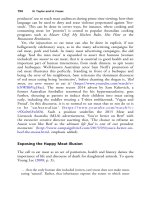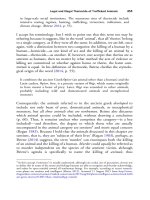The palgrave international handbook of a 453
Bạn đang xem bản rút gọn của tài liệu. Xem và tải ngay bản đầy đủ của tài liệu tại đây (41.69 KB, 1 trang )
Legal and Illegal Theriocide of Trafficked Animals
455
in large-scale social institutions. The numerous sites of theriocide include
intensive rearing regimes, hunting, trafficking, vivisection, militarism, and
climate change. (Beirne 2014, p. 55).
I accept his terminology, but I wish to point out that this term too may be
othering because it suggests, like in the word ‘animal’, that all ‘therios’ belong
to a single category, as if they were all the same. In addition, we are left, once
again, with a distinction between two categories: the killing of a human by a
human—homicide—as one kind of act and the killing of an animal by a
human—theriocide—as another. If, however, one accepts that therios are as
sentient as humans, then no matter by what method the acts of violence or
killing are committed or whether against homo or therio, the harm committed is equal. In his definition of theriocide, Beirne clarifies the etymological origin of the word (2014, p. 55);
It combines the ancient Greek θpíov (an animal other than a human) and the
Latin cỉdere. θpíov, first, is a prosaic variant of θηρ, which seems originally
to have meant a beast of prey. Later, θηρ was extended to other animals,
probably including wild and domesticated animals and metaphorical
monsters
Consequently; the animals referred to in the ancient greek developed to
include not only beast of prey, domesticated animals, or metaphorical
monsters, but all those animals that are nonhuman. Beirne also discusses
which animal species could be included, without drawing a conclusion
(p. 60). Thus, it remains unclear who comprises the category—is a bee
included?—and therefore, the degree to which those who are usually
encompassed in the animal category are sentient4 and merit equal concern
(Regan 1983). Because I hold that the animals discussed in this chapter are
sentient, that is, they are ‘subjects of their lives’ (Regan 1983), perhaps, as
Beirne (2014) suggests, the term ‘murder’ can encompass both the killing
of an animal and the killing of a human. Murder could equally be referred as
to murder independent on the species of the sentient victim, although
Beirne’s agenda is specifically to name the killing of animals, thus
4
As this concept (‘sentience’) is usually understood, although one could, out of precaution, choose not
to define this in terms of the senses and feelings humans are able to recognize and thereby acknowledge,
and rather be open minded toward all nonhuman beings. For example, according to recent research,
even plants are sentient and intelligent (Hance 2015). Accessed 11 August 2015 from http://www.
theguardian.com/environment/radical-conservation/2015/aug/04/plants-intelligent-sentient-book-brilli
ant-green-internet?CMP=Share_AndroidApp_Gmail).









